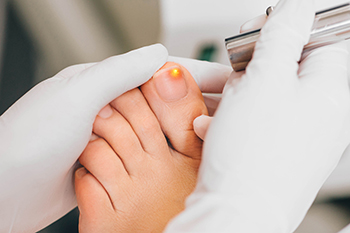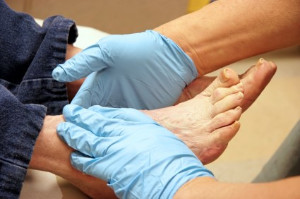Items filtered by date: December 2023
Heel Pain Can Be Treated!
Heel Pain Can Be Treated!
What to Expect From Hammertoe Surgery

Hammertoe surgery is a procedure designed to address the deformities associated with hammertoe, a condition in which one or more toe joints become bent. Before the surgery, your podiatrist will conduct a thorough evaluation, including a physical examination, and possibly perform an X-ray that can assess the extent of the deformity and determine the best course of action. They will also have a discussion with you about the procedure, its potential risks, benefits, and alternative treatments. Depending on the complexity of your case and your preferences, hammertoe surgery can be performed under local anesthesia with or without sedation, or under general anesthesia. During the surgery, your surgeon will make incisions, reposition the affected toe joint, and may remove a small piece of bone or tendon. The toe will then be straightened and secured in its corrected position, often using pins, wires, or screws. Following the surgery, you will likely wear a special shoe or cast to protect the toe. Initially, you may experience swelling and discomfort, but these symptoms can gradually improve over time. If you have a hammertoe that is causing you pain, it is suggested that you make an appointment with a podiatrist to determine whether surgery can help improve your comfort and foot function.
Foot surgery is sometimes necessary to treat a foot ailment. To learn more, contact one of our podiatrists of Geller Foot Clinic. Our doctors will assist you with all of your foot and ankle needs.
When Is Surgery Necessary?
Foot and ankle surgery is generally reserved for cases in which less invasive, conservative procedures have failed to alleviate the problem. Some of the cases in which surgery may be necessary include:
- Removing foot deformities like bunions and bone spurs
- Severe arthritis that has caused bone issues
- Cosmetic reconstruction
What Types of Surgery Are There?
The type of surgery you receive will depend on the nature of the problem you have. Some of the possible surgeries include:
- Bunionectomy for painful bunions
- Surgical fusion for realignment of bones
- Neuropathy decompression surgery to treat nerve damage
Benefits of Surgery
Although surgery is usually a last resort, it can provide more complete pain relief compared to non-surgical methods and may allow you to finally resume full activity.
Surgical techniques have also become increasingly sophisticated. Techniques like endoscopic surgery allow for smaller incisions and faster recovery times.
If you have any questions please feel free to contact our office located in Lathrup Village, MI . We offer the newest diagnostic and treatment technologies for all your foot and ankle needs.
What to Expect From Hammertoe Surgery

Hammertoe surgery is a procedure designed to address the deformities associated with hammertoe, a condition in which one or more toe joints become bent. Before the surgery, your podiatrist will conduct a thorough evaluation, including a physical examination, and possibly perform an X-ray that can assess the extent of the deformity and determine the best course of action. They will also have a discussion with you about the procedure, its potential risks, benefits, and alternative treatments. Depending on the complexity of your case and your preferences, hammertoe surgery can be performed under local anesthesia with or without sedation, or under general anesthesia. During the surgery, your surgeon will make incisions, reposition the affected toe joint, and may remove a small piece of bone or tendon. The toe will then be straightened and secured in its corrected position, often using pins, wires, or screws. Following the surgery, you will likely wear a special shoe or cast to protect the toe. Initially, you may experience swelling and discomfort, but these symptoms can gradually improve over time. If you have a hammertoe that is causing you pain, it is suggested that you make an appointment with a podiatrist to determine whether surgery can help improve your comfort and foot function.
Foot surgery is sometimes necessary to treat a foot ailment. To learn more, contact one of our podiatrists of Geller Foot Clinic. Our doctors will assist you with all of your foot and ankle needs.
When Is Surgery Necessary?
Foot and ankle surgery is generally reserved for cases in which less invasive, conservative procedures have failed to alleviate the problem. Some of the cases in which surgery may be necessary include:
- Removing foot deformities like bunions and bone spurs
- Severe arthritis that has caused bone issues
- Cosmetic reconstruction
What Types of Surgery Are There?
The type of surgery you receive will depend on the nature of the problem you have. Some of the possible surgeries include:
- Bunionectomy for painful bunions
- Surgical fusion for realignment of bones
- Neuropathy decompression surgery to treat nerve damage
Benefits of Surgery
Although surgery is usually a last resort, it can provide more complete pain relief compared to non-surgical methods and may allow you to finally resume full activity.
Surgical techniques have also become increasingly sophisticated. Techniques like endoscopic surgery allow for smaller incisions and faster recovery times.
If you have any questions please feel free to contact our office located in Lathrup Village, MI . We offer the newest diagnostic and treatment technologies for all your foot and ankle needs.
The Precise Nature of Laser Treatment for Fungal Nails

Laser treatment for fungal nails, a therapeutic modality gaining prominence, involves utilizing concentrated beams of light to target and eradicate fungal infections within the nail bed. This non-invasive procedure harnesses the power of specific wavelengths to penetrate the nail and reach the underlying fungal colonies, without causing harm to surrounding tissues. The laser energy is absorbed by the pigments in the fungal cells, generating heat that neutralizes the infection. Unlike traditional treatments, laser therapy poses minimal risk of side effects and does not necessitate medications. The exact mechanism of laser treatment for fungal nails underscores its precision, selectively targeting the fungal pathogens while preserving the integrity of the nail and surrounding structures. If you have toenail fungus, it is strongly suggested that you speak with a podiatrist who can determine if laser treatment is the correct treatment option for you.
Laser treatment can be an effective way to get rid of toenail fungus. If you have any questions about laser treatment, consult with one of our podiatrists from Geller Foot Clinic. Our doctors will assess your condition and provide you with quality treatment for fungal nails.
What Are Toenail Fungal Infections?
Onychomycosis, or fungal infection of the nail, is a relatively common and non-serious condition. Around 10 percent of U.S. citizens are afflicted with fungal nails. Common forms of fungus that infect the nail include dermatophytes, yeasts, and molds.
Symptoms of Toenail Fungal Infections Include:
- Nail thickening
- Brittleness of the nail
- Discoloration of the nail
Diagnosis for Fungal Nails
Fungal infections are diagnosed by fungal culture and microscopy. This will rule out any other conditions such as nail trauma, psoriasis, lichen planus, and onychogryphosis.
What Is Laser Treatment?
Laser treatment is a non-invasive, safe, quick, and painless procedure that uses the heat from a laser to kill fungus in the nail. Each infected nail is targeted with a laser for several minutes. The treatment is usually utilized several different times over a select period. During this time, a podiatrist will keep an eye on the infection.
If you have any questions, please feel free to contact our office located in Lathrup Village, MI . We offer the newest diagnostic and treatment technologies for all your foot care needs.
The Precise Nature of Laser Treatment for Fungal Nails

Laser treatment for fungal nails, a therapeutic modality gaining prominence, involves utilizing concentrated beams of light to target and eradicate fungal infections within the nail bed. This non-invasive procedure harnesses the power of specific wavelengths to penetrate the nail and reach the underlying fungal colonies, without causing harm to surrounding tissues. The laser energy is absorbed by the pigments in the fungal cells, generating heat that neutralizes the infection. Unlike traditional treatments, laser therapy poses minimal risk of side effects and does not necessitate medications. The exact mechanism of laser treatment for fungal nails underscores its precision, selectively targeting the fungal pathogens while preserving the integrity of the nail and surrounding structures. If you have toenail fungus, it is strongly suggested that you speak with a podiatrist who can determine if laser treatment is the correct treatment option for you.
Laser treatment can be an effective way to get rid of toenail fungus. If you have any questions about laser treatment, consult with one of our podiatrists from Geller Foot Clinic. Our doctors will assess your condition and provide you with quality treatment for fungal nails.
What Are Toenail Fungal Infections?
Onychomycosis, or fungal infection of the nail, is a relatively common and non-serious condition. Around 10 percent of U.S. citizens are afflicted with fungal nails. Common forms of fungus that infect the nail include dermatophytes, yeasts, and molds.
Symptoms of Toenail Fungal Infections Include:
- Nail thickening
- Brittleness of the nail
- Discoloration of the nail
Diagnosis for Fungal Nails
Fungal infections are diagnosed by fungal culture and microscopy. This will rule out any other conditions such as nail trauma, psoriasis, lichen planus, and onychogryphosis.
What Is Laser Treatment?
Laser treatment is a non-invasive, safe, quick, and painless procedure that uses the heat from a laser to kill fungus in the nail. Each infected nail is targeted with a laser for several minutes. The treatment is usually utilized several different times over a select period. During this time, a podiatrist will keep an eye on the infection.
If you have any questions, please feel free to contact our office located in Lathrup Village, MI . We offer the newest diagnostic and treatment technologies for all your foot care needs.
Children’s Foot Blisters

Blisters, characterized by fluid-filled bubbles on the skin, often arise from friction or injuries like burns, spider bites, or pinching, and are occasionally due to infections. In most instances, managing blisters at home is feasible. Small, intact blisters, even blood blisters, generally heal naturally. Foot blisters in children should not be disturbed if unbroken. The exception is covering it with a bandage or moleskin pad and having the child avoid activities that provoke the blister formation. If your child has a blister that ruptures, persists, causes pain, or appears infected, it is suggested that you schedule an appointment with a podiatrist for proper care.
Blisters may appear as a single bubble or in a cluster. They can cause a lot of pain and may be filled with pus, blood, or watery serum. If your feet are hurting, contact one of our podiatrists of Geller Foot Clinic. Our doctors can provide the care you need to keep you pain-free and on your feet.
Foot Blisters
Foot blisters are often the result of friction. This happens due to the constant rubbing from shoes, which can lead to pain.
What Are Foot Blisters?
A foot blister is a small fluid-filled pocket that forms on the upper-most layer of the skin. Blisters are filled with clear fluid and can lead to blood drainage or pus if the area becomes infected.
Symptoms
(Blister symptoms may vary depending on what is causing them)
- Bubble of skin filled with fluid
- Redness
- Moderate to severe pain
- Itching
Prevention & Treatment
In order to prevent blisters, you should be sure to wear comfortable shoes with socks that cushion your feet and absorb sweat. Breaking a blister open may increase your chances of developing an infection. However, if your blister breaks, you should wash the area with soap and water immediately and then apply a bandage to the affected area. If your blisters cause severe pain it is important that you call your podiatrist right away.
If you have any questions, please feel free to contact our office located in Lathrup Village, MI . We offer the newest diagnostic and treatment technologies for all your foot care needs.
Children’s Foot Blisters

Blisters, characterized by fluid-filled bubbles on the skin, often arise from friction or injuries like burns, spider bites, or pinching, and are occasionally due to infections. In most instances, managing blisters at home is feasible. Small, intact blisters, even blood blisters, generally heal naturally. Foot blisters in children should not be disturbed if unbroken. The exception is covering it with a bandage or moleskin pad and having the child avoid activities that provoke the blister formation. If your child has a blister that ruptures, persists, causes pain, or appears infected, it is suggested that you schedule an appointment with a podiatrist for proper care.
Blisters may appear as a single bubble or in a cluster. They can cause a lot of pain and may be filled with pus, blood, or watery serum. If your feet are hurting, contact one of our podiatrists of Geller Foot Clinic. Our doctors can provide the care you need to keep you pain-free and on your feet.
Foot Blisters
Foot blisters are often the result of friction. This happens due to the constant rubbing from shoes, which can lead to pain.
What Are Foot Blisters?
A foot blister is a small fluid-filled pocket that forms on the upper-most layer of the skin. Blisters are filled with clear fluid and can lead to blood drainage or pus if the area becomes infected.
Symptoms
(Blister symptoms may vary depending on what is causing them)
- Bubble of skin filled with fluid
- Redness
- Moderate to severe pain
- Itching
Prevention & Treatment
In order to prevent blisters, you should be sure to wear comfortable shoes with socks that cushion your feet and absorb sweat. Breaking a blister open may increase your chances of developing an infection. However, if your blister breaks, you should wash the area with soap and water immediately and then apply a bandage to the affected area. If your blisters cause severe pain it is important that you call your podiatrist right away.
If you have any questions, please feel free to contact our office located in Lathrup Village, MI . We offer the newest diagnostic and treatment technologies for all your foot care needs.
Symptoms of Diabetic Feet

Diabetic feet, a manifestation of diabetes-related complications, exhibit distinctive symptoms that demand attention and care. One prevalent sign is peripheral neuropathy, causing tingling or numbness in the feet due to nerve damage. Loss of sensation may lead to difficulty detecting injuries or changes in temperature. Skin changes, such as dryness, cracking, or peeling, are common, while slow healing wounds and ulcers may develop, posing a risk of infection. Changes in foot shape or deformities, including hammertoes, can arise as a result of altered biomechanics. Poor circulation in diabetic individuals may lead to cold feet, color changes, and a weakened pulse. Recognizing these symptoms is vital, as diabetic feet require meticulous care to prevent complications like infections and amputations. Regular foot examinations, proper hygiene, wearing well-fitting footwear, and blood sugar control are paramount for preserving foot health in individuals with diabetes. If you have diabetes, it is strongly suggested that you are under the care of a podiatrist who can help you to manage this serious condition.
Diabetic foot care is important in preventing foot ailments such as ulcers. If you are suffering from diabetes or have any other concerns about your feet, contact one of our podiatrists from Geller Foot Clinic. Our doctors can provide the care you need to keep you pain-free and on your feet.
Diabetic Foot Care
Diabetes affects millions of people every year. The condition can damage blood vessels in many parts of the body, especially the feet. Because of this, taking care of your feet is essential if you have diabetes, and having a podiatrist help monitor your foot health is highly recommended.
The Importance of Caring for Your Feet
- Routinely inspect your feet for bruises or sores.
- Wear socks that fit your feet comfortably.
- Wear comfortable shoes that provide adequate support.
Patients with diabetes should have their doctor monitor their blood levels, as blood sugar levels play such a huge role in diabetic care. Monitoring these levels on a regular basis is highly advised.
It is always best to inform your healthcare professional of any concerns you may have regarding your feet, especially for diabetic patients. Early treatment and routine foot examinations are keys to maintaining proper health, especially because severe complications can arise if proper treatment is not applied.
If you have any questions please feel free to contact our office located in Lathrup Village, MI . We offer the newest diagnostic and treatment technologies for all your foot and ankle needs.
Symptoms of Diabetic Feet

Diabetic feet, a manifestation of diabetes-related complications, exhibit distinctive symptoms that demand attention and care. One prevalent sign is peripheral neuropathy, causing tingling or numbness in the feet due to nerve damage. Loss of sensation may lead to difficulty detecting injuries or changes in temperature. Skin changes, such as dryness, cracking, or peeling, are common, while slow healing wounds and ulcers may develop, posing a risk of infection. Changes in foot shape or deformities, including hammertoes, can arise as a result of altered biomechanics. Poor circulation in diabetic individuals may lead to cold feet, color changes, and a weakened pulse. Recognizing these symptoms is vital, as diabetic feet require meticulous care to prevent complications like infections and amputations. Regular foot examinations, proper hygiene, wearing well-fitting footwear, and blood sugar control are paramount for preserving foot health in individuals with diabetes. If you have diabetes, it is strongly suggested that you are under the care of a podiatrist who can help you to manage this serious condition.
Diabetic foot care is important in preventing foot ailments such as ulcers. If you are suffering from diabetes or have any other concerns about your feet, contact one of our podiatrists from Geller Foot Clinic. Our doctors can provide the care you need to keep you pain-free and on your feet.
Diabetic Foot Care
Diabetes affects millions of people every year. The condition can damage blood vessels in many parts of the body, especially the feet. Because of this, taking care of your feet is essential if you have diabetes, and having a podiatrist help monitor your foot health is highly recommended.
The Importance of Caring for Your Feet
- Routinely inspect your feet for bruises or sores.
- Wear socks that fit your feet comfortably.
- Wear comfortable shoes that provide adequate support.
Patients with diabetes should have their doctor monitor their blood levels, as blood sugar levels play such a huge role in diabetic care. Monitoring these levels on a regular basis is highly advised.
It is always best to inform your healthcare professional of any concerns you may have regarding your feet, especially for diabetic patients. Early treatment and routine foot examinations are keys to maintaining proper health, especially because severe complications can arise if proper treatment is not applied.
If you have any questions please feel free to contact our office located in Lathrup Village, MI . We offer the newest diagnostic and treatment technologies for all your foot and ankle needs.


